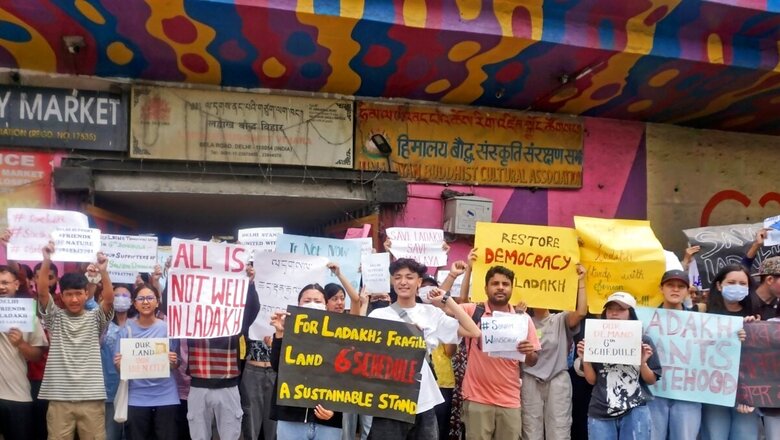
views
Ladakh, today, finds itself at a critical juncture, grappling with the competing imperatives of development, identity preservation, and constitutional rights. A critical analysis of the situation shows that the approach needs to be less confrontational and more empathetic. Let’s first try to understand what is going on in the Indian state nestled amidst the towering peaks of the Himalayas.
Activist Sonam Wangchuk has decided to call off his proposed border march to the Line of Actual Control (LAC) in the Chungathung border area. The move came in response to the Ladakh administration’s imposition of restrictions under Section 144 and the implementation of internet curbs in the region, effectively quashing the planned demonstration.
Wangchuk’s intended march was not merely symbolic; it aimed to spotlight the encroachments made by China along the border since 2020, a matter of grave concern for the Ladakhi populace. His activism, rooted in the pursuit of statehood and the implementation of the Sixth Schedule for the Ladakh Union Territory, reflects a broader sentiment among local communities clamouring for constitutional safeguards to protect their land, culture, and environment.
Central to the demands articulated by Wangchuk and allied groups is the inclusion of Ladakh in the Sixth Schedule of the Constitution. This constitutional provision, traditionally applied to tribal areas in states like Assam, Meghalaya, Tripura, and Mizoram, affords local communities a substantial say in the governance and administration of their territories, a principle fervently advocated for by Ladakhi activists.
Wangchuk’s assertion is that Ladakh is being treated akin to a colony, with external bureaucrats dictating policies governing the ecologically sensitive region. The failure of the government to honour commitments made in previous engagements, as alleged by Wangchuk, underscores the disillusionment prevailing among Ladakhis regarding the efficacy of official assurances and the urgent need for substantive action to address their grievances.
In essence, the impasse between the Ladakh administration and activist groups like those led by Sonam Wangchuk epitomises the broader struggle for self-determination and environmental stewardship in the region. As aspirations for autonomy and environmental preservation collide with the imperatives of state control and geopolitical exigencies, Ladakh finds itself in a paradoxical situation.
The demand for Ladakh to become a separate Union Territory, therefore, seemed to be rooted in legitimate grievances and aspirations of the people of the region and transitioning to a Union Territory status was seen as a means to achieve this goal, allowing Ladakhis to have more control over their own affairs and development.
However, while the creation of Ladakh as a Union Territory addressed some of these concerns, it also brought about unforeseen challenges. One significant issue was the loss of certain safeguards that Ladakh enjoyed as part of the former state of Jammu and Kashmir. For example, preferences in government jobs and educational opportunities for state residents are no longer applicable, leaving Ladakhis at a disadvantage in competing for these opportunities. This change disproportionately affected the local population, who had relied on these provisions for socio-economic advancement.
Furthermore, the establishment of Ladakh as a Union Territory also impacted the functioning of the hill development councils, which were originally set up to empower local communities and address their specific needs. The UT status potentially diluted the independence and authority of these councils, leading to concerns about the effective implementation of development projects and the preservation of local interests.
In essence, while the demand for Ladakh to become a separate Union Territory seemed justified at a conceptual level, its implementation brought about unintended consequences and challenges for the people of Ladakh. It also highlighted the complexity of governance reforms and the importance of balancing autonomy with safeguards to protect the interests of all stakeholders.
While the grievances expressed by Ladakhis regarding their rights and autonomy are significant, it is imperative to subject them to further scrutiny and analysis to ascertain their validity in demanding additional legislative safeguards as well. Despite claims of external control over policies and resources, a closer examination reveals that there are no existing mines or forests in the Union Territory of Ladakh that are being exploited or leased to outsiders or locals. Moreover, the limited presence of mineral resources, primarily ‘minor minerals,’ is predominantly utilised by locals for essential development projects such as roads and buildings.
Furthermore, there has been a substantial increase in allocations to the Ladakh Autonomous Hill Development Councils (LAHDC), with area development funds for councillors experiencing a noteworthy rise from a modest Rs 20 lakh per councillor to a commendable Rs 1.5 crore. These developments underscore the necessity for a comprehensive assessment to discern the true extent of grievances and the efficacy of existing legislative mechanisms in addressing them, thereby informing any potential need for further safeguards to protect the interests and aspirations of the Ladakhi populace.
The issue might seem paradoxical but the Indian government does not have time to reflect upon it for too long. Given Sonam Wangchuk’s popularity in Ladakh, his proposed march to the LAC was not welcome news for India. While the situation has been temporarily averted by imposing restrictions, it serves as a wake-up call for the government to address the underlying grievances effectively. Even though the government did take some prompt measures, clearly, we are still far away from an absolute solution.
The Government of India established the High Powered Committee on January 2, 2023, with the aim of addressing the pressing demands put forth by the Apex Body of Ladakh (ABL) and Kargil Democratic Association (KDA). Despite initial delays, marked by several months passing before ABL/KDA actively engaged in discussions, the committee convened its inaugural meeting on December 4, 2023. The Terms of Reference for the High Powered Committee encapsulated the core issues fueling recent agitation, ranging from safeguarding Ladakh’s distinct cultural heritage and language to ensuring land protection and employment opportunities for its people.
Additionally, the committee was tasked with exploring avenues for inclusive development, empowering the Ladakh Autonomous Hill Development Councils of Leh and Kargil, and examining potential constitutional safeguards to underpin the proposed measures. The Government of India’s unequivocal commitment to furnishing constitutional protections for the Union Territory of Ladakh was formally announced on March 4, 2024, signalling a pivotal step forward. This commitment was reinforced by ongoing consultations, including discussions on a draft framework for these safeguards during a sub-committee meeting on the same date, with representation from ABL, KDA, and officials from the Ministry of Law and Justice.
Amid escalating tensions, it’s crucial for the Indian government to also vigilantly observe China’s strategic actions in the region and adapt accordingly. China has already activated a new runway at Hotan, its closest airbase to Ladakh. The voices of Ladakh’s residents must be acknowledged, as ignoring their grievances could result in severe repercussions for both the local area and the broader national interests. It’s vital to avoid a confrontational stance that might be manipulated by neighbouring adversaries. Immediate dialogue with Sonam Wangchuk and his associates is imperative to mitigate the situation’s escalation. Domestic developmental concerns can be managed internally, without granting any advantage to India’s adversaries.
India has a long history of tensions and territorial disputes with China, particularly concerning Ladakh. The border conflict between the two nations dates back to the 1962 Sino-Indian War. Subsequent skirmishes and standoffs along the Line of Actual Control have further strained relations between the two countries, with Ladakh often serving as a flashpoint for territorial disputes.
China’s potential exploitation of issues in Ladakh against Indian interests is a genuine concern. Given the strategic importance of the region, any unrest or dissatisfaction among the local populace can be leveraged by China to undermine India’s territorial integrity and security. By engaging in dialogue and addressing grievances promptly, India can mitigate the risk of external interference and safeguard its interests in the region.
The writer takes special interest in history, culture and geopolitics. Views expressed in the above piece are personal and solely that of the author. They do not necessarily reflect News18’s views.


















Comments
0 comment